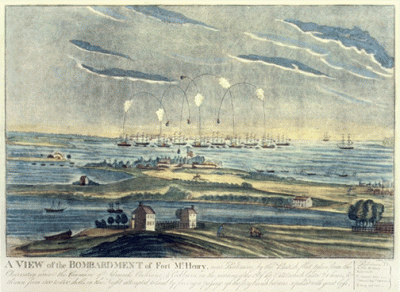
Class of ’73, ’80, and ’88 | The War of 1812 largely consisted of miscommunications and mishaps. Partly because news traveled so slowly by ship, a divided Congress was declaring war as Parliament was making concessions to avoidwar. President James Madison and his fellow Democratic-Republicans assumed the war would end quickly—hence the misleading name “War of 1812” for a war that ended up lasting almost three years. The most resounding American victory, the Battle of New Orleans, came after the war had officially ended (due, yet again, to slow traveling news).
Such a war does not lend itself easily to the pomp and ceremony that typically attend military commemorations. Yet Margot Amelia C’80, Jill Feinberg C’88, and Bill Pencek C’73 are helping the nation remember it with style and pageantry. The three Penn alumni have been helping to orchestrate the “Star-Spangled 200,” a three-year celebration of Maryland’s role during the War of 1812. The festivities will culminate this month with a “Star-Spangled Spectacular,” marking the 200th anniversary of the defense of Baltimore—and of Francis Scott Key’s composition of the poem that would become the lyrics of the national anthem.
Amelia (executive director of the Maryland Office of Tourism Development) and Feinberg (director of marketing and communications for the celebration) are handling the promotional side, while Pencek (deputy assistant secretary in Maryland’s Department of Business and Economic Development) has been lending his talents to the planning front.Back in 2007, Maryland Governor Martin O’Malley established the Maryland War of 1812 Bicentennial Commission to draft a plan for the celebration. Pencek, a Baltimore native, was named the commission’s executive director.
The organizers opted for an eclectic approach, incorporating elements of the past and present. Like most historical celebrations, the Star-Spangled 200 contains an ample number of lectures, reenactments, and historical tours. The celebration has also featured unconventional events like “Wag the Flag” (dogs parading in patriotic attire) and “#StarSpangledSelfie” (selfies with the American flag).
So far the approach has worked. An event last summer commemorating the 199th anniversary of the defense of Baltimore drew 1.5 million people, many of whom were from out of state.
“It’s not chance,” says Pencek; “it’s science that drives our decision-making in terms of our planning and assessing the success of the programs and activities that we’re putting on.”
“We’re appealing to a wide audience, because who doesn’t like the national anthem?” adds Feinberg. “Everyone can relate to the national anthem, and our celebration reflects a national sentiment and a national interest.”
Thanks to Key, most Americans unknowingly recount—before every sports event—how Fort McHenry withstood a night of intense bombardment. Yet at the time the war was deeply unpopular, particularly among Federalists in the Northeast. Key himself once referred to it as “abominable” and a “lump of wickedness,” only to reverse his position after the British began plundering his home state of Maryland.
Feinberg describes “The Star-Spangled Banner” as a kind of “lullaby.”
“We’ve done research, both quantitative and qualitative, with focus groups that shows that almost everyone has a story about the national anthem,” she says. “Parents who remember hearing it being played at Little League games, or a lot of people relate it to 9/11.”
The weeklong finale this month for the 200th anniversary of Key’s poem will feature a wide range of events that includes everything from crabcakes to fireworks. One of the highlights will be an air show featuring the Navy Blue Angels, and PBS will broadcast part of the celebration on Sept. 13. The organizers are also expecting President Barack Obama to attend.
As with many centennial celebrations, the Star-Spangled 200 also looks toward the future, particularly Baltimore’s. The organizers hope the exercise in celebratory history will instill pride in current residents and draw visitors to a city whose image has sometimes been closer to Randy Newman’s “hard town by the sea” than to the place that inspired a national anthem.
“We find that [outsiders] know very little or have a negative impression” of Baltimore, says Pencek. “This is a great time to put ourselves back in the national narrative, in the national spotlight, and change minds about this place.”
On September 12, 1814 (“Defenders Day”), Maryland citizen-soldiers mounted heavy resistance outside Baltimore against seasoned British regulars while sharpshooters felled the British commander who had put Washington to the torch. The next night, an oversized flag stubbornly flew over Fort McHenry as the Royal Navy pounded the fort with more than 1,500 rounds of rockets, mortars, and cannonballs.
The defense of the city brought national acclaim to the residents of Baltimore and the Maryland defenders, and today Defenders Day is a state holiday. By halting the British invasion, Maryland helped reunite a nation on the brink of fracturing apart.
The defense of Baltimore is one of the most straightforward and stirring tales of the war. Yet when Amelia, who grew up there, was attending Penn, few of the people she met knew much about it.
“I was stunned that people didn’t know this story—that such an important story for us growing up here wasn’t known outside of Maryland,” she says.
Now, maybe it will be.
—Matt Fernandez C’14

